You may have seen the wonderful Hackaday article (and resulting discussion) titled "Ask Hackaday: What about the Diffusers?" The article was a good summary of common techniques used to diffuse LED brilliance and the ensuing discussion listed some additional approaches and materials to try. I particularly like the idea of milled Corian, but I don't see a way to fit that into my project. It did remind me that Jimmy Diresta did a Corian lamp for Core77's Youtube channel a while back. It's a good demo of the material.
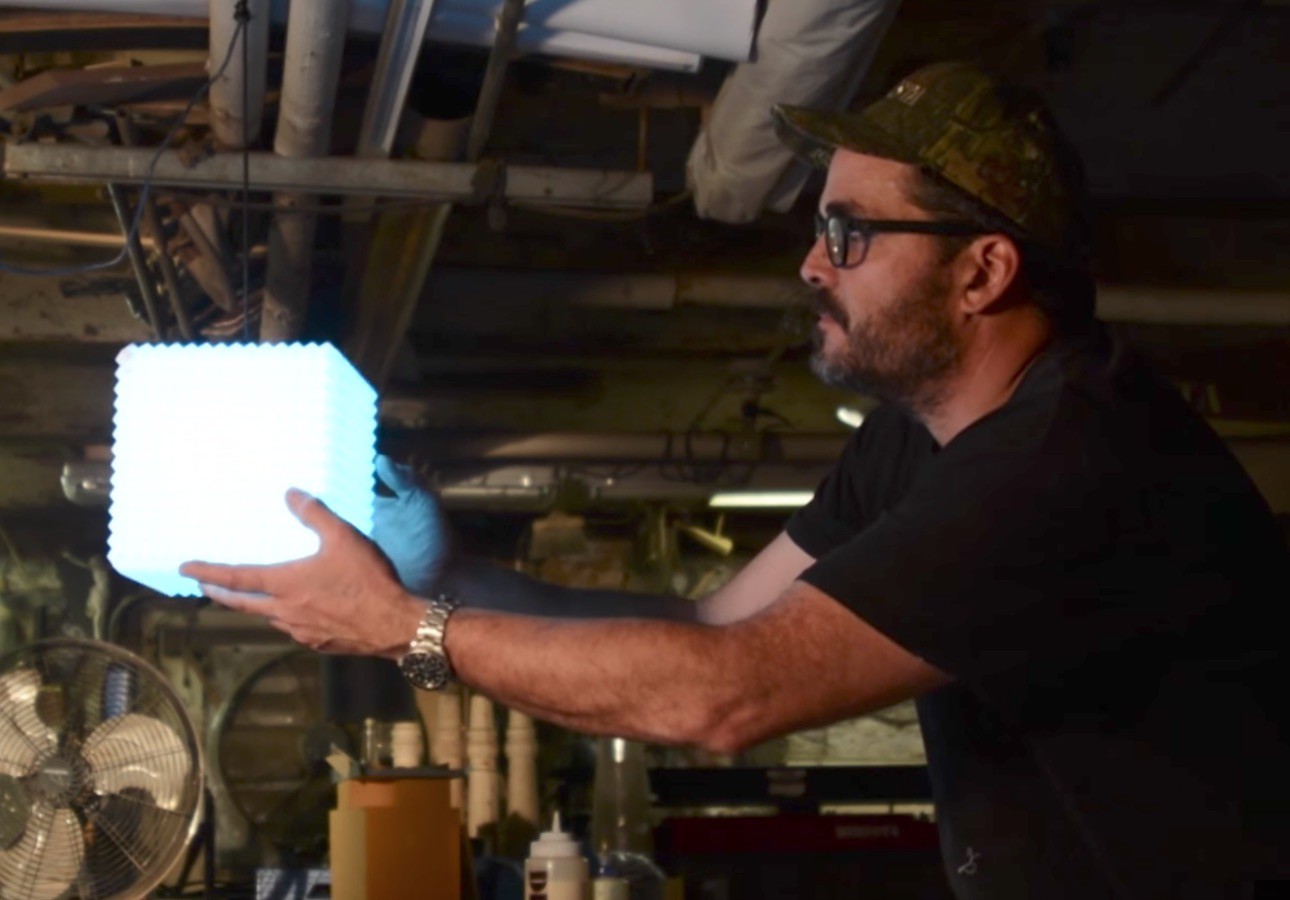
A month ago, there was also this great post about LED diffusion on the Arduino sub-reddit.
The materials I've been considering have been a bit simpler than most. They are, in no particular order:
- PETG sheet (1/16" & 1/8" thick)
- Privacy glass film
- Dragonflex cast silicone
- Frosted acrylic sheet (1/4" & 1/8", both 31% transmissive & 40% transmissive)
- Frosted & clear acrylic cut in a living hinge pattern
- 3d-printed patterns using "white" and "natural" PLA
- Stencil film (Mylar, 4mil thick)
- Other kinds of vellum-like material from Blick's
There are several criteria I have been using for judging material:
- Diffusive ability (obviously)
- Structural capacity (can it hold its own shape)
- Flexibility (can it be bent to the curves I am considering)
- Availability / cost / amenable to manufacturing
The diffusiveness of the material should be around 50%-60% light-transmissive it seems. I don't have a good way to measure this except by eyeballing it.
The availability / cost / manufacturability aspects mean I discount the cool "hacks" I normally would do like pingpong balls or hot glue. I'm looking for products or materials or processes that conceivably can be done by a hired third party.
The structural and flexibility issues are fundamentally at odds with one another: the materials that are very flexible cannot hold their shape. Many of the diffuser shapes I want to make exhibit two different types of curvature (e.g. curve around the LEDs while also following the curve of the lamp). This combined curvature is not possible from a sheet material that cannot deform. (This is also why you can't form an accurate flat map of the world. See this Numberphile video about Gaussian curvature for an easy-to-see explanation using pizza)
So anyway, here are the results thus far.
PETG sheet
The PETG sheet by itself was immediately out of the running. It is much too clear. However it is very flexible and easily cuttable with a box cutter. It became a nice substrate for some of the other materials that couldn't hold their own shape.
Silicone
This is very promising. I cast 1"-diameter 2ft long tube in a D-profile and used it as a diffuser for the "helixMetal1" lamp.

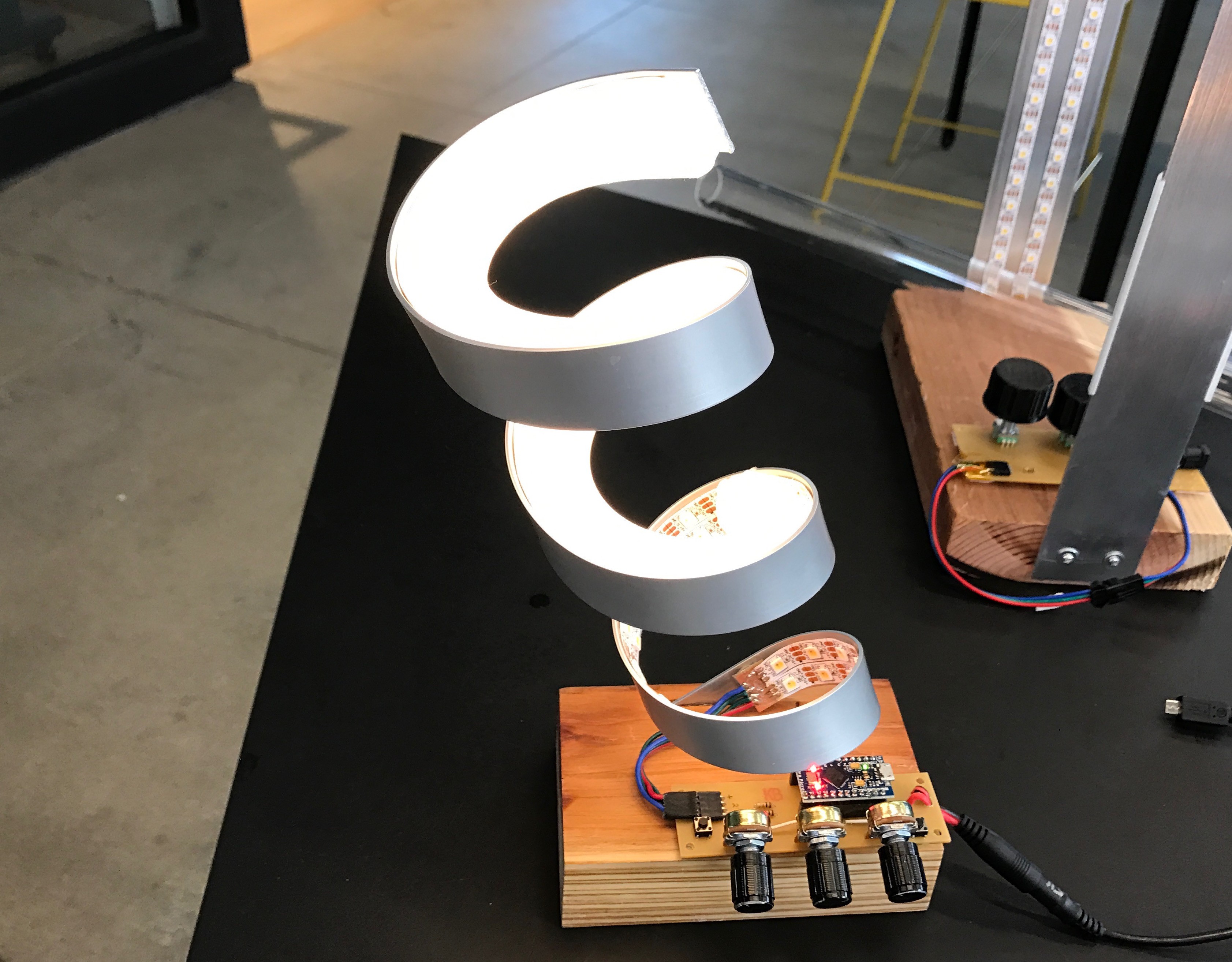
It turned out pretty well, but absorbed too much of the light. I think making a thinner shape that sits above the LEDs by some air gap is the next experiment to try.
Privacy glass film
The privacy film is some of the best material tested so far. It is a thin film (~4mil) made of vinyl I think. Since it is a flexible film, it needs to be attached to a structure. It worked wonderfully on the edge-lit acrylic of the "ufo1" lamp.

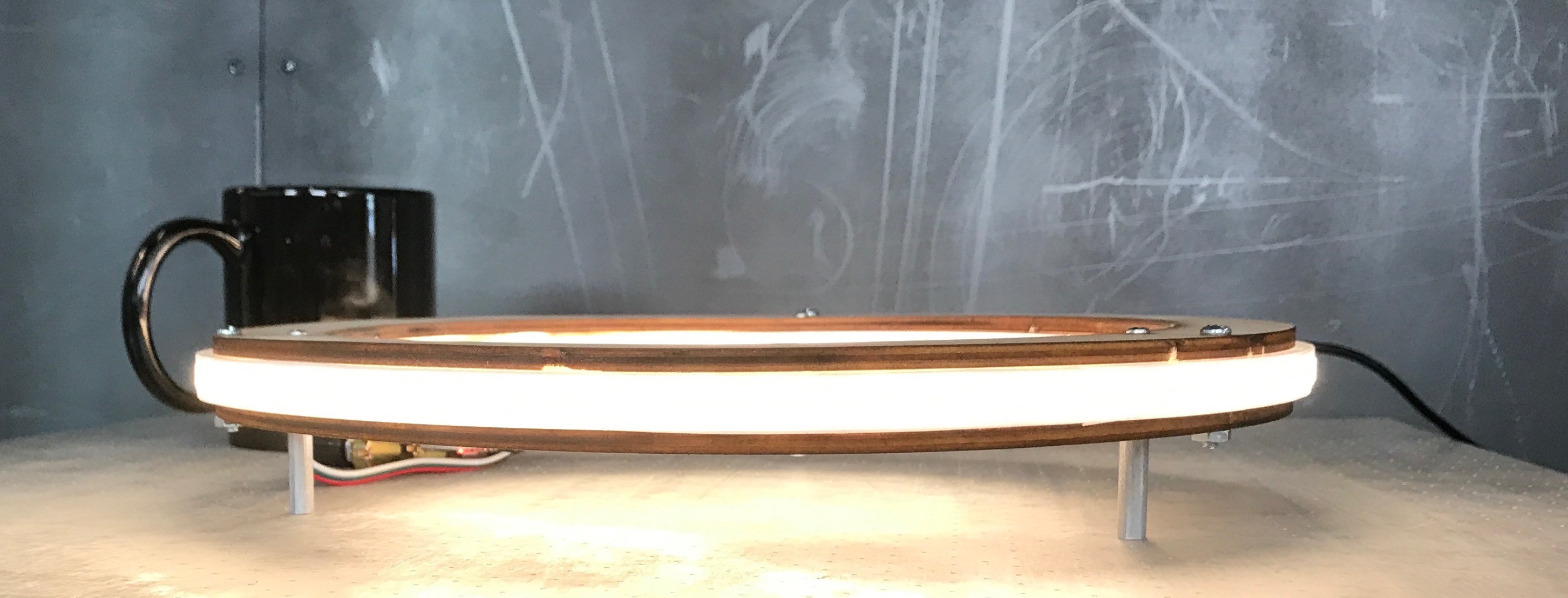
To give the film structure, I bonded it to the PETG sheet using spraymount adhesive. This worked well and allowed me to create some very interesting diffusers that looked great.

I'll definitely be exploring uses of the privacy film more. It comes in a variety of patterns, which could be very useful:
and since I think it is vinyl, it should cut well on the Design Lab's vinyl cutter.
Laser-cut Acrylic Sheet
Acrylic sheet is probably the first material people think of for LED diffusion. Frosted acrylic works well for flat surfaces and edge-lit clear acrylic can look pretty awesome too.
But my stuff is curves, so what to do? One answer is heat-bending the acrylic. I have had some success with this, but I've been trying to stay away from processes that could get you hurt. So what else? How about the laser-cut living hinge? There are several living hinge designs on the Net, most are for wood, and they all work to varying degrees with acrylic. I have tried several.


The 1/4" acrylic is too thick to be useful; the 1/8" works okay. Thinner than 1/8" frosted acrylic sheet is hard to come by. The big downside of acrylic, especially when riddled with the many cuts of a living hinge pattern, is that it's very brittle and fractures suddenly. The clear 1/8" acrylic living hinge is a very interesting visual result. Not a diffuser exactly but it does cut down the glaringness of the light. I kind of like it. That effect might show up on a future lamp.
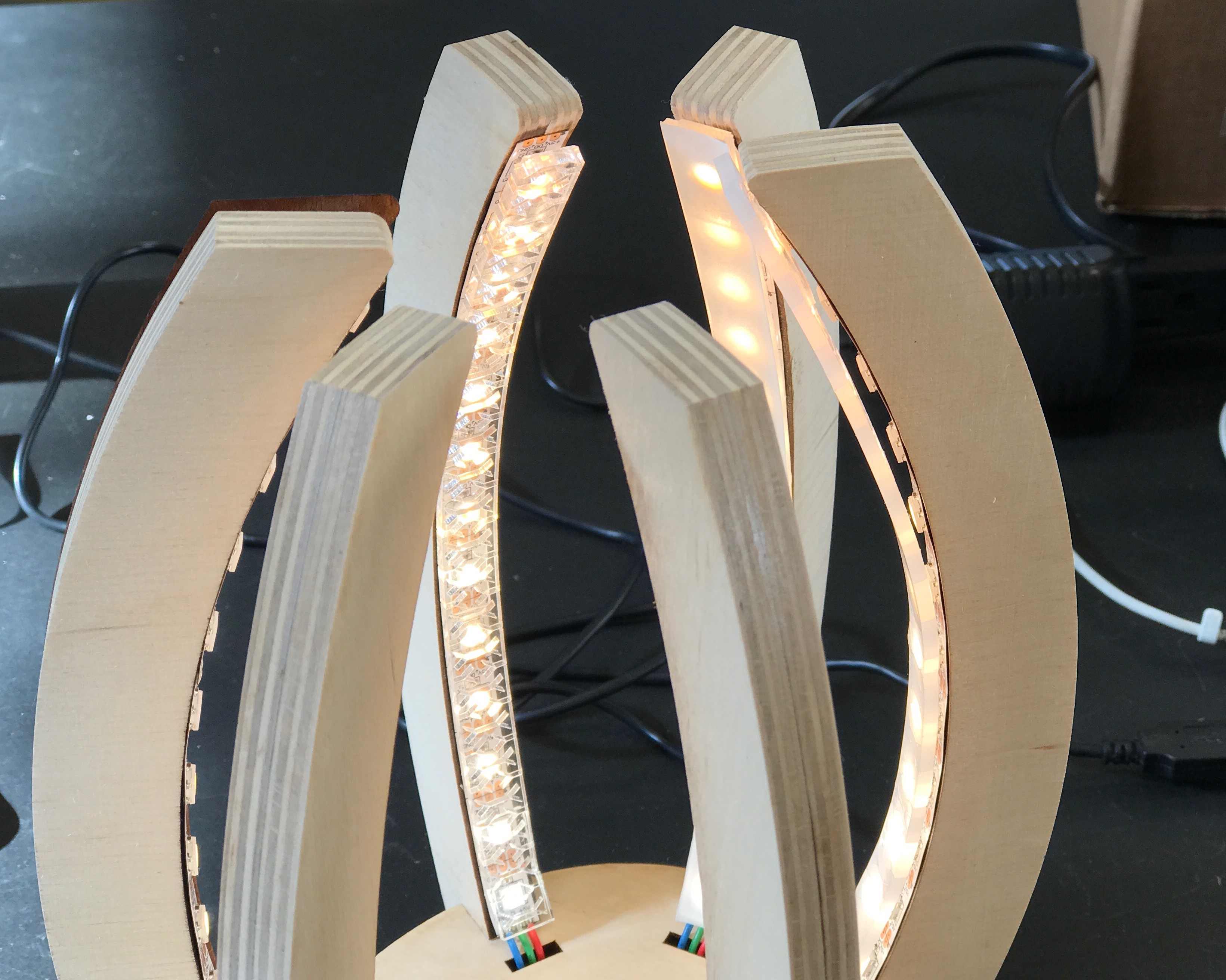
3d-printed patterns
In a separate effort, I designed two different types of 3d-printable diffusers. The first type is a segmented clip system. Some of my lamp prototypes have an aluminum bar structure the LEDs are mounted to and these clips grip the aluminum bar, surrounding the LEDs. This looked good for straight runs but failed on curves.
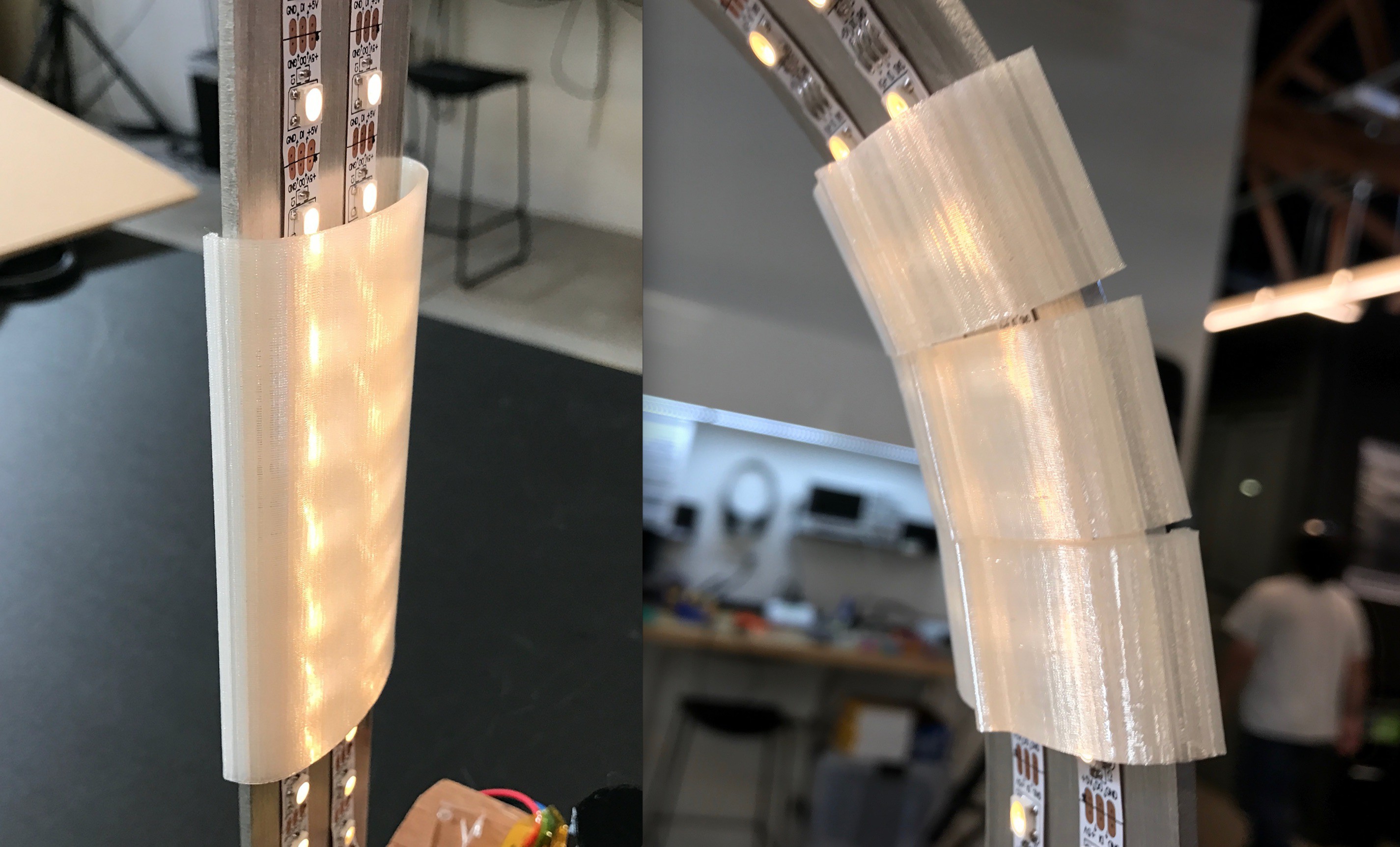
If I have a design that has very explicit radii of curvature, then I can design curved clips to go along with it. But while I'm still free-hand bending things, this technique fails.
The other 3d-printed diffuser idea was a set of "hats" for each LED element. These ended up being really fun, sort of organic. And even when printed in white PLA (normally a material I'd consider opaque), they felt bright. Since they were open at the top, light could still escape and the sides of the "hats" acts as bounce reflectors.
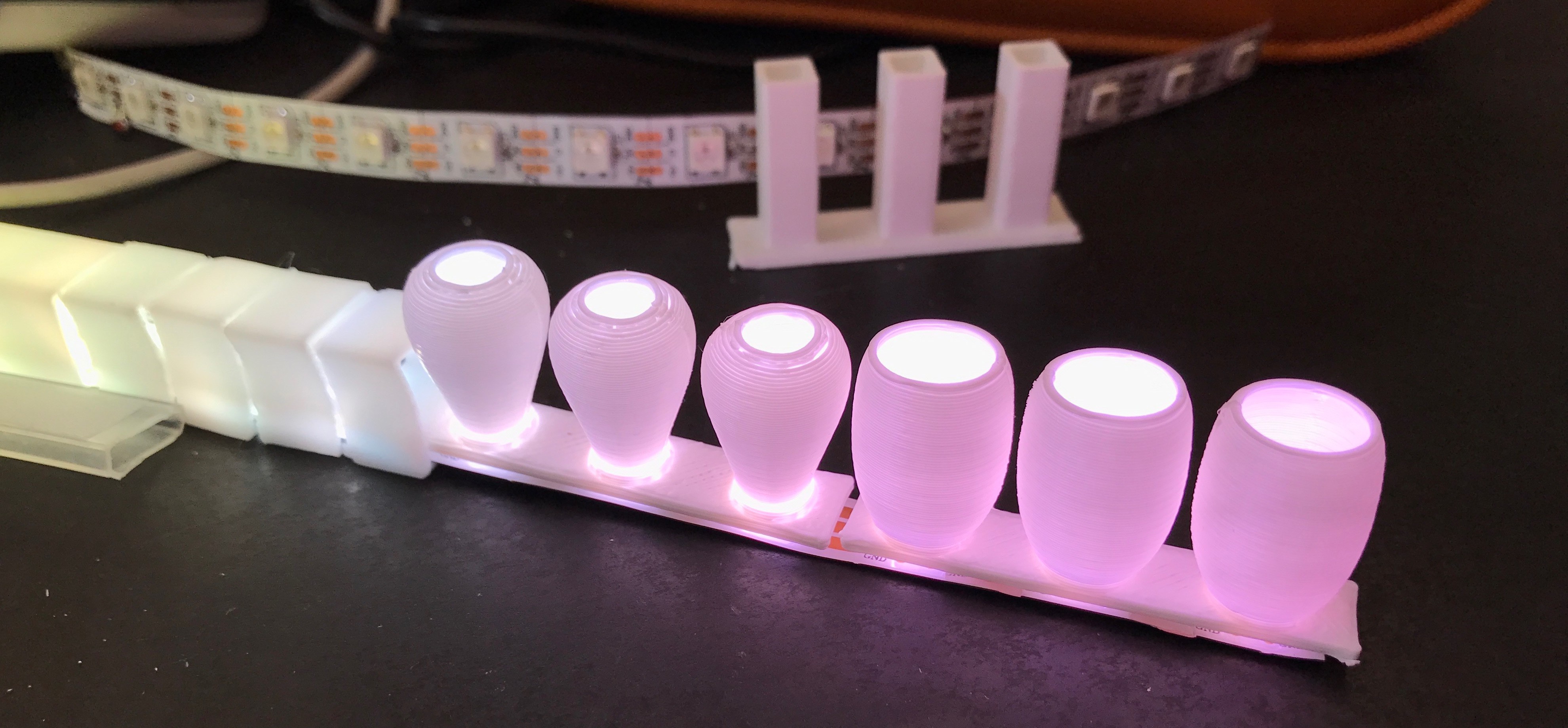
I printed them in segments of 3 units with a base of only 1mm thick so it could bend along with the LED strip. This was a fun experiment but I don't think I'll be using it for ILOVELAMP. I will use the idea for other projects though.
Stencil film and vellums
Pretty much everything said for the privacy film works for the stencil film. These materials are used by artists & designers as a tracing paper (so they are translucent, sometimes clear), but most is actually made of a thin plastic, I think polypropylene. This is makes it nonporous ,which is nice. However it's harder to find stencil film in dimensions larger than 12", and the film is considerably more expensive than vinyl film. One to-do: research bulk rolls of non-vinyl plastic films.
Biggest takeaways
I felt from the start that I needed an air gap between the LEDs and the diffusion material. I was hoping in my month or so of exploration, I could come up with a solution that let me attach a diffuser directly or nearly so to the LEDs. I want to make structures as thin as possible and the air gap needs to be at least 9mm (1/3") to eliminate hotspots, no matter what the diffusion material. (Or more precisely, for the diffusion materials I'm willing to consider that don't absorb the light so much)
Next Steps
Going forward I'm going to continue with the vinyl privacy film (and other translucent vinyl films), backed with some clear flexible structure like PETG even acrylic with a living hinge cut (the vinyl could then act to help front fracturing) I might make a trip to Gavrieli's soon as they have so many types of vinyl film.
 todbot
todbot

Discussions
Become a Hackaday.io Member
Create an account to leave a comment. Already have an account? Log In.
Cool, I would recommend pex tube, and everything HDPE, it is a great light diffusing material.
Are you sure? yes | no
Super helpful reference. I've used smooth on solaris silicone + white pigment to good effect. Probably the preferred product for potting electronics. Wood veneers are also a nice diffuser for a different look.
Are you sure? yes | no
Thanks for the informative post!
I have found these sheets to work extremely well: https://www.inventables.com/technologies/light-diffuser-films
Also, you might want to check out photography flash diffuser films, eBay or Amazon might have some (it is a bit hard to find initially though).
Are you sure? yes | no
Hi Maksim, this is a great idea. I initially discounted them because Inventables has them in such small sizes for my application. But if this flash diffuser film, then I think I have seen rolls of that.
Are you sure? yes | no
I picked up a sheet of 1/16" Delrin from McMaster the other day and it shows some real promise. Leaps and bounds ahead of the other stuff I tried (HDPE, polypro, polysty, LDPE, UHMW, nylon, etc). P/N 8573K11.
Are you sure? yes | no
You can get Delrin in 1/16"? That's totally awesome. I'll definitely pick some of that up. And agreed it should be much better than the PP and LDPE that I've tried. Thanks for the tip!
Are you sure? yes | no
Yeah, I'm playing around with using 3mm discs pressed into PCB holes to diffuse bottom-mounted RGB LEDs. Much cleaner than silicone. For your purposes, Delrin is pretty ideal as its mechanical properties are super baller.
Are you sure? yes | no
That solution with the 3mm discs in PCB holes sounds really neat. I'd love to see pics of how it turns out.
Are you sure? yes | no
Hi zakqwy, this was a great idea. I picked up some 1/16", 1/32" and 3/32" Delrin sheets from McMaster. They work great! And pretty inexpensive too.
Are you sure? yes | no
Wow! Very neat results and great writeup!
I also tried the silicone route, but the stuff I was using ended up being too clear, or maybe I wasn't laying it down thick enough.
Are you sure? yes | no
Thanks Eliot! And thanks for the article a couple of weeks ago. It finally got me to get all my notes together and make this post! As for silicone, I had similar past experiences (using silicone caulking compound), but this molding silicone like Dragonflex has a nice milky cloudiness to it.
Are you sure? yes | no